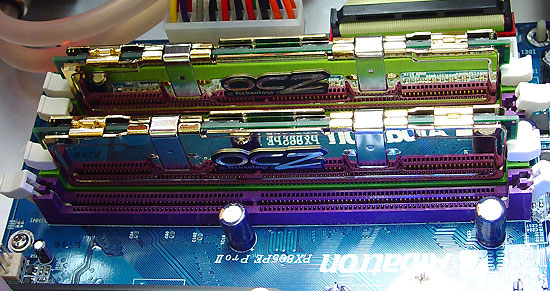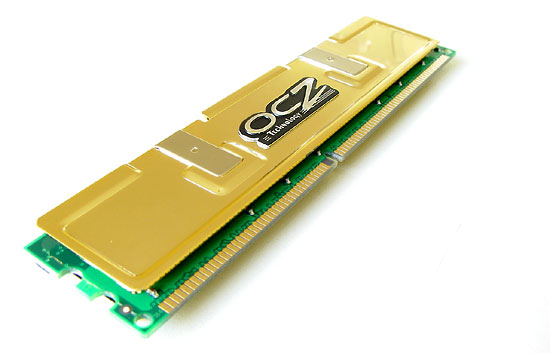Page 2
We'll start off with the regular A-B-C of memory. When you recently bought a PC, or for that matter are buying a new system you'll notice that most PC's make use of DDR400 (PC3200) memory. It's the most commonly used type as this memory matches your PC's CPU bus speed. That CPU bus speed, also known as "front-side bus speed" (or FSB), is the speed at which the CPU communicates with RAM memory and the motherboard chipset. Athlon XPs have a 266, 333 or 400 MHz FSB, Pentium 4s have a 400MHz, 533MHz or 800MHz and the newer 1066 MHz FSB, AMD Durons have a 200MHz FSB and socket 478 Celerons have a 400MHz FSB and so on and so on.
When choosing a FSB speed for the CPU you choose, be aware that you'll need to purchase memory capable of this faster speed. For example, many people are enticed by the remarkably low priced memory, yet you need to sync your memory to your CPU's FSB. First of all, all mainboard these days use either DDR or DDR2 memory, the mainboard we used needs DDR memory. In our case we know that the CPU we have uses the 800 MHz bus so we're gonna need DDR memory rated PC3200, thus 400 MHz DDR memory that is capable of handling that FSB. Just divide the CPU FSB by 2 and you are set to go.
So in our case we want to make make use of 400-533 MHz DDR memory if we are going to overclock (increase the FSB). Why all the way to DDR533 ? Simple, the platform we'll use today is equipped a Northwood based platform / Pentium 4 processor locked at 2.8 GHz. Since the processor is locked we need to increase the, there is the magic word again, FSB. The Pentium 4 processor my friends uses a quad pumped bus as Intel calls it so nicely. A 800 MHz FSB sounds better then 4x200 MHz. When you start fooling around with that FSB you better make sure you have some really good memory as the increased FSB will have a huge impact on the memory also.
Secondly, always make sure you buy two bars so that you can have a dual-channel memory configuration, which effectively double's the memory bandwidth and the Pentium 4 loves that bandwidth for sure. Allow me to introduce the a picture of this RAM..
 Armed and ready to be fired up.
Armed and ready to be fired up.
Judging from the specifications, the module is a really voltage hungry when you start to overclock. If you want it run it at DDR400 it already is recommended to set your DDR voltage at 2.8v. You can image that when you start to overclock that number needs to go up.
What's rather weird is that once you have installed the memory and fire up your rig, the SPD timings of this memory are not set standard at 2-2-2-5. Instead we see much slower 2.5-3-3-6 timings.
- 400MHz DDR
- CL 2-2-2-5 (CAS-TRCD-TRP-TRAS)
- Also available in a 512MB Module
- Unbuffered
- Gold Layered Copper Heatspreader
- Lifetime Warranty
- 2.8 Volts
- 184 Pin DIMM
Initially I though hmm... OCZ should deliver the suggested timings at default and not slower ones. But after thinking a little about it, this was done for a good reason. The voltage level for 2-2-2-5 timings divert from Jedec standard (bigtime). So, some mainboards will not support the higher voltage level, which can result in a crashing system. So this was obviously done for one reason only, safety. Once you are in the BIOS, select 2.8 Volts for your DDR memory, set the timings at 2-2-2-5 and you'll notice you can rock on into Windows or whatever OS you prefer ;).

